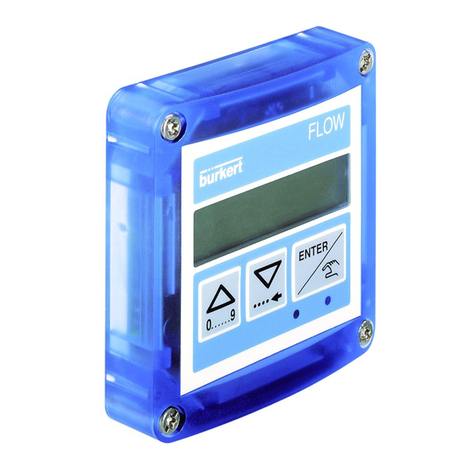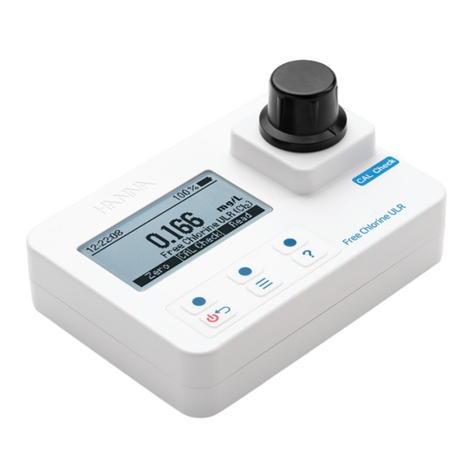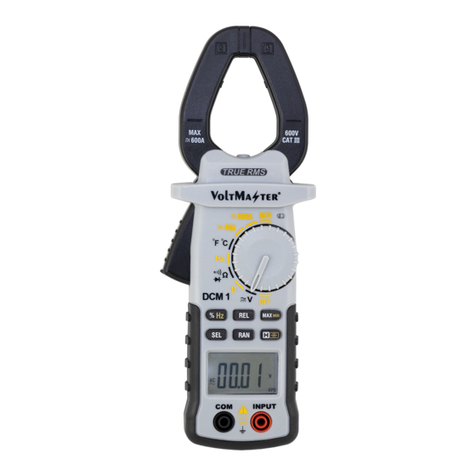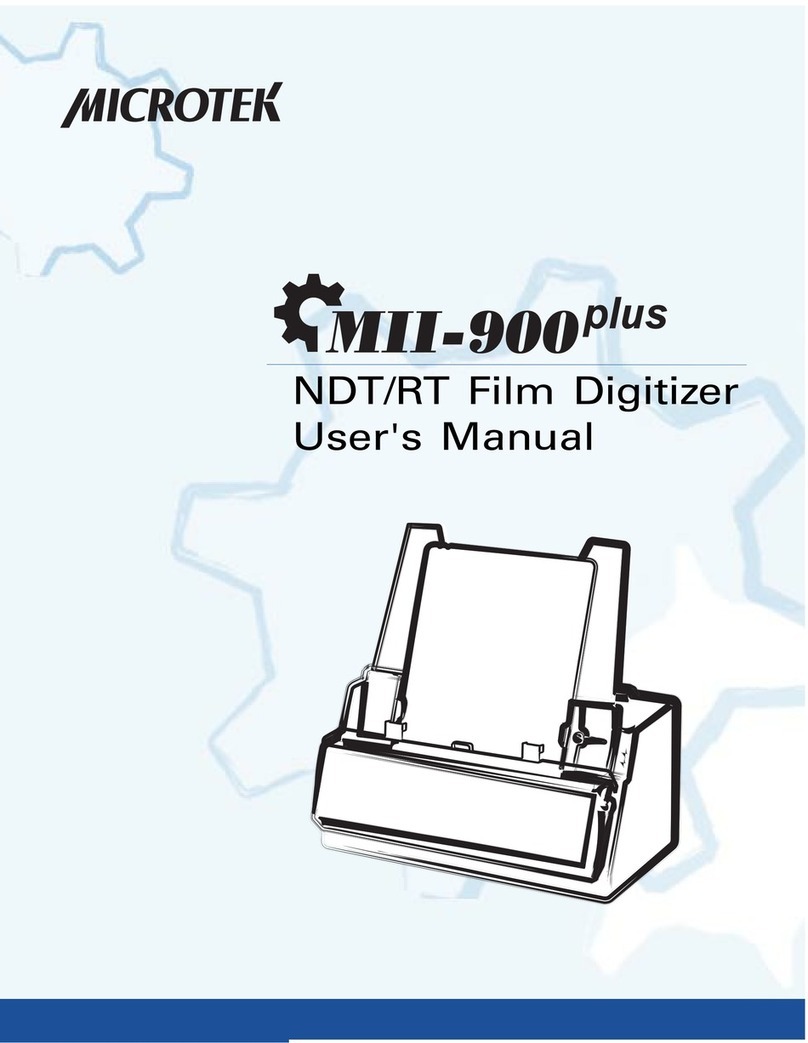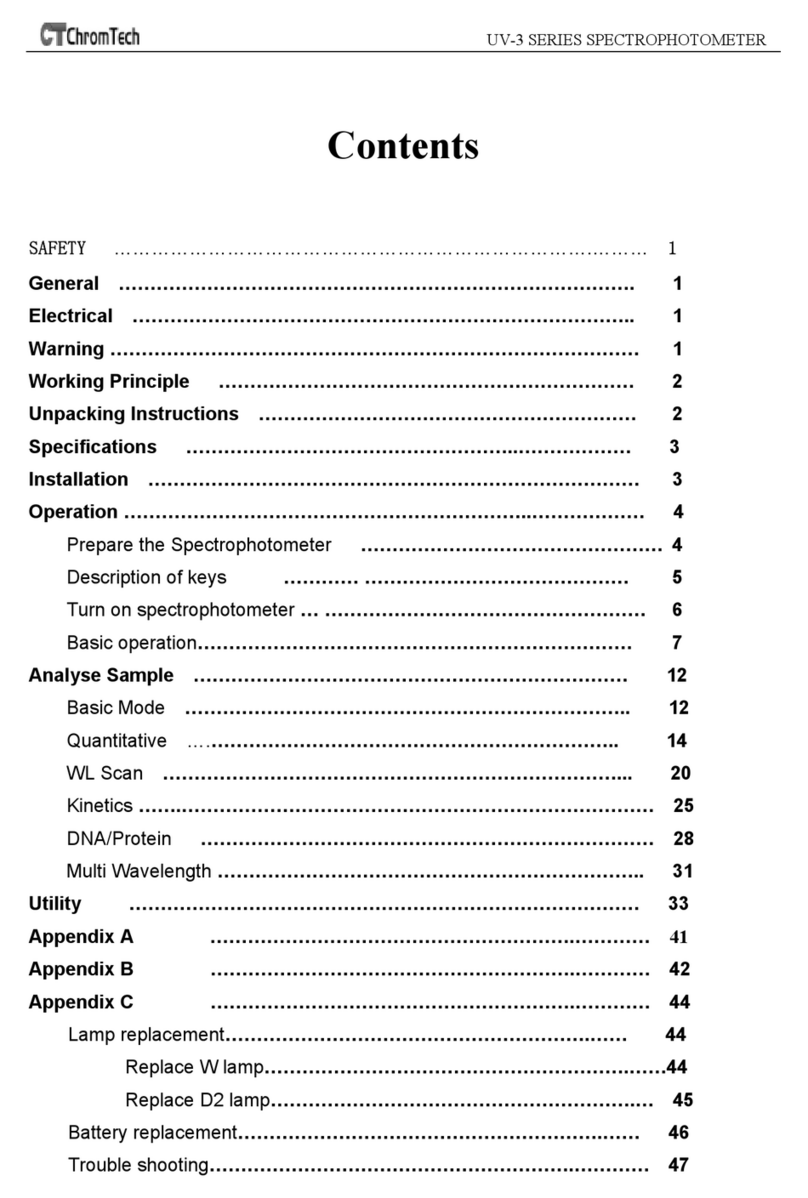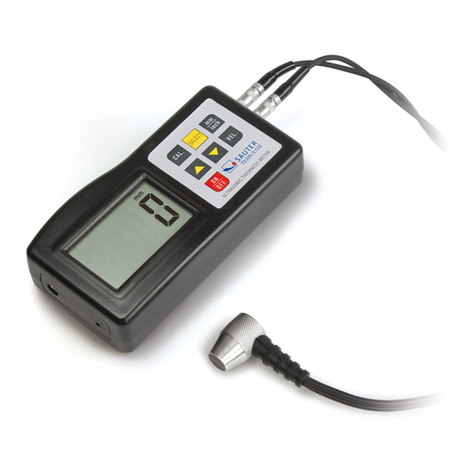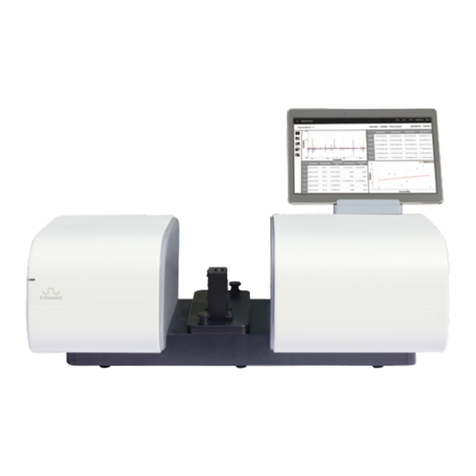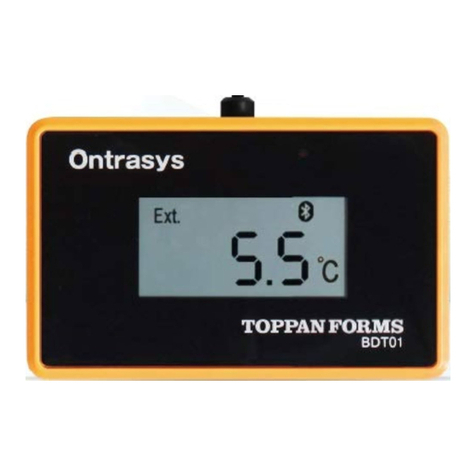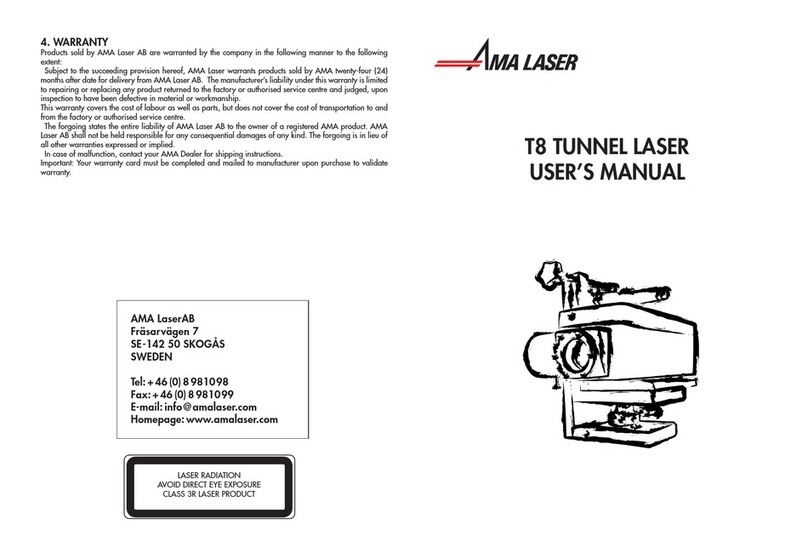Dr.Thiedig Digox 601 sodium User manual

Operating Instructions
Sodium Analyser
Digox 601 sodium

Digox 601 sodium
©Copyright July 2011, Dr. Thiedig + Co, Berlin. All rights reserved.OM_digox601sodium_Vers110728.docx
Copyright
Make sure to read the documentation carefully before
installing or commissioning the unit, and ensure com-
pliance with all safety regulations. Dr. Thiedig + Co
shall not assume any liability for damage caused by
non-compliance with the Operating Instructions. The
use of spare parts and consumables other than those
coming from Dr. Thiedig + Co shall invalidate all war-
ranty claims.
Any information contained in the Operating Instruc-
tion shall be subject to modification without prior no-
tice, and shall not be construed as constituting a
commitment on the part of Dr. Thiedig + Co.
This Operating Instruction shall not be reproduced or
transmitted in full or in part by any means, electronic
or mechanical, without the prior written approval of
Dr. Thiedig + Co.
If the Operating Instruction is translated into different
languages, the German version shall be deemed the
original one.
Copyright
Lesen Sie diese Dokumentation vor der Installation
oder Inbetriebnahme sorgfältig und beachten Sie die
Sicherheitshinweise. Bei Schäden, die durch Nich-
tbeachtung der Bedienungsanweisungen entstehen,
kann die Dr. Thiedig + Co keine Haftung überneh-
men. Garantieansprüche erlöschen ebenfalls bei
Verwendung von Ersatzteilen und Betriebschemika-
lien, die nicht von der Dr. Thiedig + Co stammen.
Die in dieser Dokumentation enthaltenen Informatio-
nen können ohne Vorankündigung geändert werden
und stellen keine Verpflichtung seitens der
Dr. Thiedig + Co dar.
Diese Dokumentation darf weder vollständig noch
auszugsweise mit irgendwelchen Mitteln, elektronisch
oder mechanisch, ohne vorherige schriftliche Ge-
nehmigung der Dr. Thiedig + Co reproduziert oder
übertragen werden.
Wenn die Dokumentation in verschiedene Sprachen
übersetzt wurde, ist die deutsche Fassung als Origi-
nal anzusehen.

Digox 601 sodium
3/110
Table of Contents
General Information...............................................................................................................................................5
Safety Guidelines...................................................................................................................................................6
1Introduction.............................................................................................................................................8
1.1Intended use................................................................................................................................8
1.2Storage........................................................................................................................................8
1.3Features and characteristics of the Digox 601 sodium...............................................................8
1.4Technical Data.............................................................................................................................9
1.5Measuring principle and structure of measuring chain..............................................................10
1.6Structure of measuring chain.....................................................................................................10
1.7PPE/speciality tools required.....................................................................................................11
2Installation of Digox 601 sodium........................................................................................................12
2.1Unpacking..................................................................................................................................12
2.2Checking the scope of delivery..................................................................................................12
2.3Assembly...................................................................................................................................13
2.3.1Installation requirements, anchorage points, connections........................................................13
2.3.2Swivelling out of the swing gate ................................................................................................14
2.4Hydraulic connection .................................................................................................................15
2.4.1Medium inlet ..............................................................................................................................15
2.4.2Outflow.......................................................................................................................................15
2.5Electrical connection..................................................................................................................16
2.5.1Important information regarding the connection of the device..................................................16
2.5.2Power connection......................................................................................................................17
2.5.3Connection of sensors...............................................................................................................17
2.5.4Flow monitoring .........................................................................................................................18
2.5.5Analogous output.......................................................................................................................18
2.5.6Relay outlet................................................................................................................................18
2.5.7Serial Interface (option).............................................................................................................19
2.5.8Terminal connection plan with measuring turbine.....................................................................20
2.5.9Terminal connection plan with level switch ...............................................................................21
3User interface/assembly of the device...............................................................................................23
3.1Main components ......................................................................................................................23
3.2Functions and operating conditions...........................................................................................25
3.2.1Flow diagram.............................................................................................................................25
3.2.2Operating condition "measuring" (blue line)..............................................................................26
3.2.3Operating condition "calibrating" (blue and violet line)..............................................................26
3.2.4Operating condition "alkalifying " (blue and green line).............................................................27
3.3Operator panel and operating elements....................................................................................28
3.4Description of display functions.................................................................................................29
3.5Menu structure Digox 601 sodium.............................................................................................30
3.5.1Preliminary remarks...................................................................................................................30
3.5.2Main menu.................................................................................................................................30
3.5.3Basic settings code 086.............................................................................................................34
3.5.4Basic settings code 099.............................................................................................................37

Digox 601 sodium
4/110
4Commissioning and decommissioning of the Digox 601 sodium ..................................................39
4.1Commissioning..........................................................................................................................39
4.1.1Short description of commissioning/preconditions for commissioning......................................39
4.1.2Adjustment of sample flow.........................................................................................................39
4.1.3Insertion of electrodes...............................................................................................................39
4.1.4Insertion of the pump hoses......................................................................................................43
4.1.5Connection of the alkalising reagent .........................................................................................44
4.1.6Calibration of the pH measurement...........................................................................................44
4.1.7Calibration of the temperature measurement............................................................................45
4.1.8Calibration of the sodium measurement....................................................................................45
4.2Reagent exchange ....................................................................................................................45
4.2.1Preliminary remarks...................................................................................................................45
4.2.2Reference solution.....................................................................................................................45
4.2.3Calibration solution....................................................................................................................45
4.2.4Alkalising agent .........................................................................................................................46
4.3Decommissioning ......................................................................................................................46
5Maintenance/regular check of the Digox 601 sodium ......................................................................47
5.1Maintenance switch/hold function .............................................................................................47
5.2Laboratory sample (option)........................................................................................................48
5.3Maintenance function ................................................................................................................49
5.3.1Brief description.........................................................................................................................49
5.3.2Device settings and analogous outlets......................................................................................49
5.3.3Sample flow, valves, gassing, ion exchanger and pumps.........................................................49
5.3.4Filling levels of the operating chemicals....................................................................................50
5.3.5Calibrate temperature measurement and pH measurement.....................................................50
5.3.6Hose exchange..........................................................................................................................50
5.3.7Cleaning of the flow-through valve............................................................................................50
5.3.8Etching stipulations Na+ sensors ...............................................................................................51
6Error messages and error correction.................................................................................................52
7Factory defaults/parametrisation........................................................................................................53
7.1General note..............................................................................................................................53
7.2Basic settings for code 86 .........................................................................................................54
7.3Basic settings code 099.............................................................................................................55
8Spare parts and consumable material...............................................................................................56
9Annex.....................................................................................................................................................58
9.1Safety data sheets for operating chemicals ..............................................................................58
9.1.1Safety data sheet Ion exchanger resin......................................................................................58
9.1.2Safety data sheet Reference solution 1,000 ppb Na+...............................................................68
9.1.3Safety data sheet Calibration solution 5,100 ppb Na+..............................................................73
9.1.4Safety data sheet Diisopropylamine..........................................................................................78
9.1.5Safety data sheet Etching reagent A.........................................................................................89
9.1.6Safety data sheet Etching reagent B (liquid)...........................................................................101
9.2Declaration of Conformity Digox 601 sodium..........................................................................107

Digox 601 sodium
5/110
General Information
This technical information contains instructions for the installation and commissioning as well as the maintenance
and repair of the measurement device Digox 601 sodium, which is described in the following.
For the purpose of clarity, this document does not consider any and all detailed information regarding every single
type or every possible way of installation and operation.
Please read this documentation thoroughly before carrying out any installation and commissioning work and pay
attention to the safety guidelines. In case of damage caused by the non-observance of the operating instructions,
Dr. Thiedig + Co. KG shall not assume any liability. Warranty claims shall also become unenforceable if spare parts
and operating chemicals are used which have not been supplied by Dr. Thiedig + Co. KG.
The information contained in this documentation may be altered without prior notice and shall not construe any
obligation of Dr. Thiedig + Co. KG.
This documentation may not be reproduced or transferred, neither partially nor as a whole, by any means, neither
electronically nor mechanically, without obtaining the prior written approval by Dr. Thiedig + Co. KG
The device support for the Digox 601 product line and its components is carried out by our subsidiary Dr. Leye
GmbH.
Should you require further information or in case of any problems which are not extensively covered by this docu-
ment, you can directly request such information from:
Dr. Leye GmbH
Friedrich-Engels-Str. 14
09326 Geringswalde - Germany
Tel.: +49 37382 / 842 - 0
+49 37382 / 842 - 15
Fax: +49 37382 / 842 - 19
www.dr-leye.com
We would also like to point out that any warranties in the sense of our general terms and conditions of delivery are
only assumed if:
−installations, connections, adjustments, commissioning and maintenance of the device are exclusively carried
out by duly qualified, authorised specialist staff,
−only original spare parts are used in case of repairs, and if
−the device is only used in accordance with the provisions of this technical information.
The safety information highlighted in this document must be adhered to in any case.
If these operating instructions are translated into another language, the German original shall take precedence at
all times.

Digox 601 sodium
6/110
Safety Guidelines
In this technical information, the accentuations Warning, Caution and Notice shall have the following meaning:
1Warning!
This heading indicates that any inaccurate adherence or non-adherence to the operating instructions, work in-
structions, prescribed work flows and similar could lead to injuries or accidents.
*Caution!
This heading indicates that any inaccurate adherence or non-adherence to the operating instructions, work in-
structions, prescribed work flows and similar could damage the device or lead to measurement errors.
)Notice:
This heading is used to highlight a special characteristic.
The device has been constructed and tested according to the protective measures for electronic devices and has
left the works in a flawless condition with regards to safety.
In order to maintain this condition and to ensure hazard-free operation, the operator is obliged to respect the notes
and warnings contained in this technical information. If it must be assumed that hazard-free operation is no longer
possible, the device is to be decommissioned and secured against unintended use. This is the case:
oif the device shows visible damage,
oif the device no longer seems to be functional,
oif the device has been stored under unfavourable conditions.
The device is to be installed and commissioned by specialised staff. Any installation works may only be carried out
in a voltage-free state. The device is to be connected with a 3-pole power cable. Any interruptions of the protective
earth conductor are to be regarded as dangerous and thus inadmissible! If you suspect that secure operation is no
longer possible due to damage, the device must be decommissioned immediately!

Digox 601 sodium
7/110
1Warning!
The Digox 601 sodium may only be operated and maintained by persons familiar with the analyser who have
read and understood the operating instructions at hand.
1Warning!
The installation and connection of the device and its additional components (e.g. recorder) are to be carried out in
accordance with the relevant safety provisions. Work may only be carried out by trained and authorised staff.
Only tools which are suitable for the respective task may be used!
*Caution!
The installation site should be chosen in order to prevent that the device is subject to mechanical and chemical
load.
)Notice:
Before commissioning the device, all parameters are to be checked for correct adjustment.

Digox 601 sodium
8/110
1 Introduction
1.1 Intended use
Analysers of the Digox 601 sodium series have been designed to meet the specific industrial quality requirements,
in particular when it comes to:
oQuality assurance of demineralisation systems
oMonitoring of the water-steam cycle in power plants, in particular the monitoring of condensers
oQuality assurance of the ultra-pure water circulation in the semiconductor industry
Typical measurement points in power plants:
oMonitoring of process-related mixed bed exchangers
oMonitoring of the water quality of the water-steam cycle
1Warning!
For the Digox 601 sodium, the use of diisopropylamine is required. The tightness of the test tube and the gassing
hoses is to be checked regularly!
1.2 Storage
Principally, the measurement device is to be stored in a dry place protected from moisture. For further information
refer to 1.4 Technical Data.
*Caution!
In case of temperatures around or below zero, it must be ensured that there is no water left in the device. Ion
exchangers, alkalising agents and sensors are to be stored at temperatures above +1°C.
1.3 Features and characteristics of the Digox 601 sodium
oMenu-guided operation via five keys with plain text display,
oTwo password-protected operating levels,
oFour-line display with backlight for displaying the measured sodium value, temperature, current pH value
as well as start/stop and error messages. The following error messages can be issued: water shortage,
Na+ slope factor, pH slope factor, reagent shortage (diisopropylamine) and/or calibration solution level.
An ongoing calibration will be displayed as message in the measurement menu.
oDisplay of all measured values with measurement units,
oRelay outlet (potential-free make contact, fail-safe) for collective failures,
oAnalogous outlet to the desired measurement range between 0/4… 20mA parametrisable,
oTemperature compensation: manual with temperature specification or automated to 25°C

Digox 601 sodium
9/110
1.4 Technical Data
Mains voltage 85…265 V, 48 – 63 Hz, parameter protection without batteries
Power input 40 VA
Protection class IP65 (measuring transducer), IP54 (external housing)
EMC in accordance with DIN EN 61000-6-3 and DIN EN 61000-6-4
Display LCD display, four lines, backlit
Power output 0/4-20mA galvanically isolated, maximum load 400ohm
Registration range: arbitrary within the measurement range
Interface (option): RS485
Relay outlet 1 alarm relay with potential-free make contact
Releasing relay in case of failure (fail-safe)
Contact load 6 A/250 V, maximum 550 VA ohmic load
(with RC contact protective circuit)
Connections spring-type terminals for cables of up to 1.5 mm²
Dimensions WXHXD 500x700x250mm
Weight approx. 30 kg
Admissible ambient
temperature during operation 0 to +40°C1
Admissible storage temperature 1°C (-20°C2) up to +65°C
Admissible humidity max. 90% at 40°C (non-condensing)
Sample inlet pressure 0.2-3 bar
Sample quantity 5…20 l/h (overflow principle), minimum quantity 5 l/h
Sample condition max. temperature 50°C, min. pH value 7.00
Feed connection coupling for hose with an external diameter of 6 mm
Overflow tank connection protective sleeve for hose with an internal diameter of 8 mm
Outlet connection protective sleeve for hose with an internal diameter of 8 mm
Measurement principle differential measurement of two ion-sensitive Na electrodes
Measurement range 0.1-2,000 ppb
Accuracy 3% of the displayed measured value
Input resistance (Na) >109ohm
Temperature sensor Pt100
Calibration two-point calibration by means of adding a defined parent solution to the deion-
ised sample stream, to be executed manually or automatically
Alkaline treatment pH-regulated with undiluted Diisopropylamin, consumption approx. 0.5 l/month,
optionally ammonia solution
Electrical safety IEC 1010, IEC 664
Labelling CE mark, serial number
1An adequate sample temperature is to ensure that the temperature within the device does not reach zero.
(keep the door closed)
2In case of temperatures around or below zero, it must be ensured that there is no water left in the device. Ion
exchangers, alkalising agents and sensors are to be stored at temperatures above +1°C.

Digox 601 sodium
10/110
1.5 Measuring principle and structure of measuring chain
The Na+ measurement is carried out potentiometrically with ion-selective electrodes, and can be described by
means of the Nernst equation:
)*log(**303,2 1
0x
Z
x
Na
Na aKa
nF
RT
UU −
+
+∑
++= (1)
U = measured voltage signal
U0= standard potential
RT/nF = Nernst factor or slope factor/inclination as quotient of the product of the universal gas constant R
and the absolute temperature T as well as the product of the number of charge transfers n (for
Na+= 1) and the Faraday constant F
aNa = activity of Na+ions
KNa+= selectivity coefficient
ax= activity of the interfering ion
Zx= valency of the interfering ion
The sensibility of the measuring assembly to interfering ions complies with the following law:
Ag+ >> H+ >> Na+ > >Li+ > K+ (2)
This is why the H+ion activity of the neutral or slightly alkaline sample water is reduced to a regulated pH value of
10.80 ±0.053.
1.6 Structure of measuring chain
According to the flow order (see Fig. 1), the measuring assembly comprises a measuring electrode, a temperature
sensor, a reference electrode and a pH electrode for regulating the pH value. Before the measuring electrode, the
pH conditioning of the sample takes place.
The Na measuring chain has the following electro-chemical structure:
Measuring electrode: AgCl(S)/Ag - 0.01 M NaCl - glass membrane - Na+ (measuring solution)
Reference electrode: Ag/AgCl(S) - 0.01 M NaCl - glass membrane - alkaline 1,000 ppb Na+ - diaphr. - measuring solution
The structure of the chain indicates that two identical Na+ glass electrodes measure simultaneously. One Na glass
electrode is in a reference container with a ceramic diaphragm and 1,000 ppb Na+. This electrode serves as refer-
ence electrode. (see Fig. 1).
3If the Na+concentration lies within the ppt range, the pH value must be significantly higher

Digox 601 sodium
11/110
Fig. 1 Structure of the measuring chain in a flow-through valve
The benefits of such a set-up are:
1. Symmetric chain structure to the greatest possible extent
2. No interfering ions
3. The concentration of the reference electrolytes is approx. 105times smaller than with other reference elec-
trodes. Thus, any diffusion potential can almost be excluded.
1.7 PPE/speciality tools required
1Warning!
When handling the equipment and chemicals to be used in the device, the respective PPE (personal protective
equipment) is to be used. The applicable legal standards with regards to work safety as well as the internal regu-
lations of the site of usage serve as basis for using the PPE.
This is particularly valid if the alkalising reagent diisopropylamine is being used.
1Warning!
Only tools which are approved for the respective task may be used! No speciality tools are required. Customary
screwdrivers and screw-wrenches are required.
Medium inlet
Temperature sensor
PT100
Gassing
Ceramic diaphragm
Measuring elec-
trode
Reference
electrode
pH electrode
Overall outle
t
Reference
containe
r

Digox 601 sodium
12/110
2 Installation of Digox 601 sodium
2.1 Unpacking
When accepting the delivery, the packaging is to be checked for external damage. Any possible damage is to be
documented and immediately reported to Dr. Thiedig + Co. KG. The disposal of the transport packaging and the
packaging material is to be carried out in accordance with the customer's waste management concept.
2.2 Checking the scope of delivery
The scope of delivery is to be checked for completeness, immediately after unpacking the goods and using the
delivery note. Any differences between the delivery note and the goods delivered are to be immediately reported to
Dr. Thiedig + Co KG. Any complaints which are effected later on will not be acknowledged. The scope of delivery,
in particular any accessories, could vary depending on the specific order.

Digox 601 sodium
13/110
2.3 Assembly
2.3.1 Installation requirements, anchorage points, connections
The analyser is to be installed within a dry, vibration-free environment. The analyser should be protected against
direct solar radiation. The analyser is to be installed in a horizontal position, on a vertical support plate (assembly
plate or wall). For assembly and operating purposes, on each side of the analyser, a free space of at least 100mm
is recommended, while in front of the analyser, an operating space of at least 600mm must be kept. Water and
cable connections are to be installed from below; for this reason a free space of at least 200mm must be provided
underneath the analyser. See Fig. 2.
Fig. 2 Assembly dimensions
cEarth bolt, M8
dOutlet of overflow container
eOutlet of flow-through valve
fMedium inlet
gCable gland, M16x1.5
hCable gland, M20x1.5
iCable gland, M20x1.5

Digox 601 sodium
14/110
2.3.2 Swivelling out of the swing gate
The four screws in each corner of the base plate are to be loosened with an Allen wrench (SW 6) and the swing
gate is to be folded out of the analyser housing. (see Fig. 3 and Fig. 4)
Fig. 3 Example for the position of the retaining screw (top left corner)
Fig. 4 Folded-out swing gate
Retaining screw

Digox 601 sodium
15/110
2.4 Hydraulic connection
2.4.1 Medium inlet
The position of the sample inlet is shown in Fig. 5. The connection is carried out via a hose with an external diame-
ter of 6mm. The hose is inserted into the fitting at the housing.
Fig. 5 Sample inlet
2.4.2 Outflow
The position of the sample outlets is shown in Fig. 6. The connection of both outlets is carried out via a hose with
an internal diameter of 8mm. The outlet must lead to a suitable collective outlet. In order to prevent backwater, the
outlet hose must not be longer than 1m; the water must be able to drain off freely.
Fig. 6 Outlets

Digox 601 sodium
16/110
*Caution!
If the swing gate is swivelled out when the device is opened, the hoses are to be pulled back into the housing.
After swivelling in, the hoses are to be pulled out of the housing again, in order to guarantee free outflow. When
swivelling in the swing gate, the hoses must not be jammed or folded. Sufficient extra hose length is to be pro-
vided for swivelling out in case of an exchange of hoses or a fixed installation.
1Warning!
By using diisopropylamine, the outlet water is contaminated by the latter. The discharge and/or the disposal of
outlet water is subject to the waste management concept of the operator!
2.5 Electrical connection
2.5.1 Important information regarding the connection of the device
1Warning!
Connection of the device/execution of all electrical works at the device may only be carried out by duly trained
and authorised members of staff!
)Notice:
The position and dimensions of the cable inlets are shown in Fig. 2.
*Caution!
The cables for the mains connection and the signal transfer are to be laid according to Fig. 7. When swivelling in
the swing gate, the cables must not be jammed or folded. Sufficient extra cable length is to be provided for swiv-
elling out during installation.
Fig. 7 Laying supply cables
As it is common for micro-process controlled devices, certain precautionary measures are to be observed with re-
gards to the installation and wiring of the device. Apart form the general regulations corresponding to the relevant
state-of-the-art, the following is to be observed in particular:

Digox 601 sodium
17/110
oInput and control lines are to be laid separately from each other as well as from power lines.
oInput and analogous outlet lines are to be shielded. (shields must only be earthed on one side, e.g. at the
device).
oRelays and protective coils must be interference-suppressed.
oWhen inductive loads are to be switched, they must either be interference-suppressed or the relay con-
tact must be protected by means of an RC protective circuit at the terminal plate of the Digox 601 sodium
, in accordance with the following tables and schematic circuit diagrams.
2.5.2 Power connection
*Caution!
Before connecting the device, the supply voltage is to be switched off!
The connection of the mains voltage is to be effected at the terminals (L), (N) and (PE), see Fig. 8. The supply volt-
age (standard 230VAC, 50-60Hz/optional 130VAC, 24VAC, 50-60 Hz) is indicated at the type plate!
Fig. 8 Mains supply terminals (L1), (N) and (PE)
*Caution!
Connecting the device to the wrong supply voltage can lead to the destruction of the device!
2.5.3 Connection of sensors
The sensor cables are completely wired ex factory. The allocation of the various sensors is marked by means of
labels in order to prevent confusion. The sensor cables are extremely sensitive and must not be folded under any
circumstances! The cable connections and plugs are to be protected from moisture and corrosion. Fig. 9 shows the
correct allocation of sensor cables.

Digox 601 sodium
18/110
Fig. 9 Allocation of sensor plugs
*Caution!
The cable connections and plugs are to be protected from moisture and corrosion!
2.5.4 Flow monitoring
Monitoring the sample flow guarantees that it is always the most recent medium which is analysed. For this pur-
pose, a measuring turbine (until serial no. 64101102600046) or a level switch (as of serial no. 64101103000047) is
integrated into the device. The measuring turbine is located at the inlet of the overflow container, while the level
switch is installed in the overflow container itself. The usage of a speed probe requires an additional resistor (see
terminal connection plan, chapter 1.4).
Under the menu point 6Basic settings 4water shortage, a respective selection is to be carried out (flow = measur-
ing turbine/contact = level switch) by using the code 86.
2.5.5 Analogous output
At outlet 1 of the analogous output card, the measured value of the sodium concentration is provided as current
signal. The other outputs are inactive. The parameterisation of the initial and final value, as well as of 0/4-20mA is
to be effected with code 86 under the menu point 6Basic settings 4analogous outlet. (For image of the analogous
output see terminal connection plan chap. 2.5.8 or 2.5.9)
*Caution!
For connecting the current output, a shielded cable is to be used. The shield is to be laid unilaterally on PE.
When connecting the power outlet, the polarity and the maximum load (400 ohm) must be taken into considera-
tion!
2.5.6 Relay outlet
The analyser Digox 601 sodium comprises an alarm relay with a potential-free exchanger. The relay is activated
under failure-free operation (contact closed) and opens in case of failure. Functional reliability and wire breakage
protection are thus guaranteed (for illustration of the relay connection see terminal connection plan chap. 2.5.8 or
2.5.9).
If inductive loads are switched (including relay and contactor coils), they must be interference-suppressed. If this is
not possible, the relay contact is to be protected with a safety circuit according to Table 1.
pH = pH electrode
Ref. = reference electrode
Meas. = measuring electrode

Digox 601 sodium
19/110
In the case of DC voltage, the relay and/or contactor coil is to be dejammed by means of a free-wheeling diode.
Fig. 10 Interference suppression in case of DC and/or AC voltage and
Table 1 Values for protective circuit
*Caution!
In case potential-free relay outlets are being used, they must be equipped with a corresponding pre-fuse provided
by the customer! The values for the maximum contact load can be obtained from the Technical Data in chapter
1.4.
2.5.7 Serial Interface (option)
Optionally, the analyser Digox 601 sodium can be equipped with a
serial interface RS485.
)Notice:
RS485 has the following specifications:
baud rate 9600, 8 data bits, 1 start and 1 stop bit, no parity, maximum cable length 1,200m.
Current up to Resistance R Condenser C
60mA 390 Ω2 watts 10nF 260V~
70mA 22 Ω2 watts 47nF 260V~
150mA 47 Ω2 watts 100nF 260V~
1.0A 47 Ω2 watts 220nF 260V~

Digox 601 sodium
20/110
2.5.8 Terminal connection plan with measuring turbine
*Caution!
The connection of the supply voltage is not executed via the circuit board of the device, but at the remote terminal
block (see Fig. 11).
Table of contents
